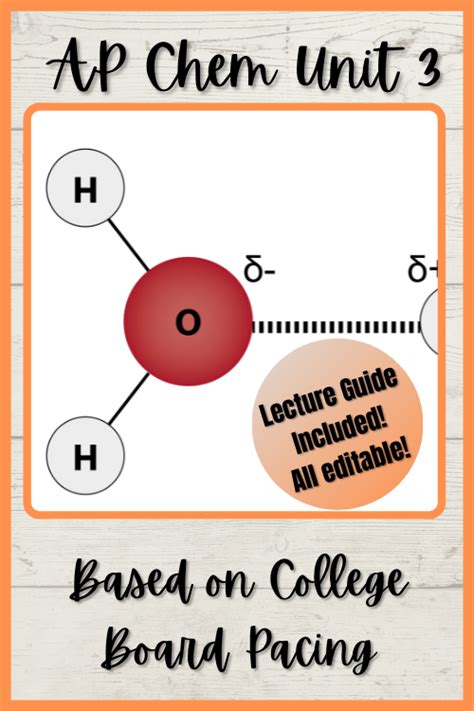Introduction
Intermolecular forces (IMFs) are the forces that act between molecules. They govern the physical properties of matter, such as melting point, boiling point, and solubility. Understanding IMFs is crucial for AP Chemistry students, as it provides the foundation for explaining and predicting the behavior of chemical compounds.

Types of Intermolecular Forces
There are three main types of IMFs:
- Hydrogen Bonding: These forces occur between molecules that contain highly electronegative atoms (e.g., N, O, F) bonded to hydrogen. The electronegative atom pulls the electron density away from the hydrogen, creating a partial positive charge on the hydrogen and a partial negative charge on the electronegative atom. Hydrogen bonding is the strongest type of IMF.
- Dipole-Dipole Interactions: These forces occur between polar molecules, which have a permanent separation of charge due to the uneven distribution of electrons. The positive end of one molecule is attracted to the negative end of another molecule.
- London Dispersion Forces: These forces occur between all molecules, including nonpolar molecules. They arise due to the instantaneous, temporary imbalances in electron distribution within molecules. These imbalances create transient dipoles that induce opposing dipoles in neighboring molecules, resulting in weak attractive forces.
Physical Properties of Matter
IMFs play a significant role in determining the physical properties of matter:
Melting Point and Boiling Point
IMFs hold molecules together in the solid and liquid states. Stronger IMFs require more energy to overcome, leading to higher melting and boiling points. For example, water has a high boiling point of 100°C due to strong hydrogen bonding.
Solubility
IMFs also influence the solubility of compounds. “Like dissolves like,” meaning that polar compounds dissolve in polar solvents, and nonpolar compounds dissolve in nonpolar solvents. This is because IMFs between solute and solvent molecules must be comparable for dissolution to occur.
Applications of Intermolecular Forces
IMFs have numerous applications in various fields:
Pharmaceutical Research
IMFs can be used to design drugs that specifically target certain tissues or molecules. By understanding the IMFs involved in biological interactions, researchers can develop drugs that have optimal potency and efficacy.
Materials Science
IMFs play a crucial role in the development of materials with specific properties. For instance, the strong IMFs in graphene contribute to its exceptional strength and electrical conductivity.
Food Chemistry
IMFs are responsible for the texture and flavor of many foods. For example, the gel-like consistency of gelatin is due to the strong hydrogen bonding between water molecules and gelatin proteins.
Tables
Table 1: Examples of Compounds with Different IMF Strengths
| Compound | IMF Type | Boiling Point (°C) |
|---|---|---|
| Water | Hydrogen Bonding | 100 |
| Ethanol | Dipole-Dipole | 78.5 |
| Hexane | London Dispersion | 69 |
Table 2: Physical Properties Influenced by IMFs
| Physical Property | Intermolecular Forces |
|---|---|
| Melting Point | Stronger IMFs result in higher melting points. |
| Boiling Point | Stronger IMFs result in higher boiling points. |
| Solubility | Polar solutes dissolve in polar solvents; nonpolar solutes dissolve in nonpolar solvents. |
Table 3: Applications of Intermolecular Forces in Different Fields
| Field | Application |
|---|---|
| Pharmaceutical Research | Drug targeting and optimization |
| Materials Science | Design of materials with specific properties |
| Food Chemistry | Texture and flavor development |
Strategies for Success
Effective Strategies
- Visualize IMFs: Use diagrams to visualize how IMFs act between molecules.
- Understand the Relationship between IMF Strength and Physical Properties: Study the periodic table and correlations between molecular structure and IMF strength.
- Practice Predicting Properties: Test your understanding by predicting the boiling points and solubility of compounds based on their IMFs.
Tips and Tricks
- Remember the Hierarchy of IMF Strengths: Hydrogen bonding > Dipole-dipole interactions > London dispersion forces.
- Identify the Most Important IMFs: In a compound with multiple types of IMFs, identify the strongest IMF as the dominant force shaping its properties.
- Consider the Compound’s Molecular Structure: The shape and polarity of a molecule influence the strength and orientation of its IMFs.
Conclusion
Understanding intermolecular forces is essential for predicting and explaining the physical properties of matter. This knowledge has far-reaching applications in fields such as chemistry, materials science, and medicine. By mastering the concepts of hydrogen bonding, dipole-dipole interactions, and London dispersion forces, AP Chemistry students can deepen their understanding of chemical systems and their relevance to the world around us.
